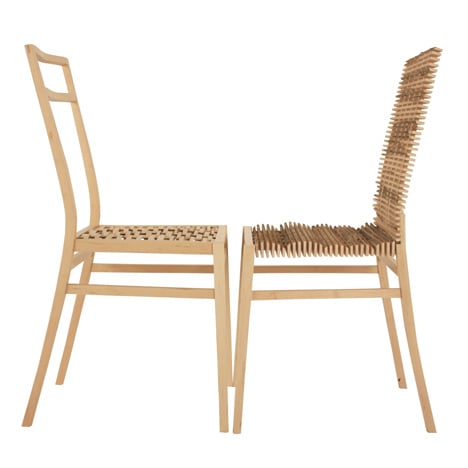University of Lincoln graduate Sebastian Cox has made a range of furniture from unseasoned coppiced hazel wood.
Presented at New Designers in London earlier this month and entitled Products of Silviculture, the range consists of two chairs, a lamp and a hat stand.
The Suent Chair (above) has a steam-bent solid hazel frame and a seat made of woven green hazel, which can be replaced as it wears out.
The back and seat of the Kerf Chair (above) are made of sawn hazel branches joined to the frame without glue, so that the structure strengthens as it dries and shrinks.
The Rod Desk Lamp (above) has a stem made from a steam-bent hazel branch and a shade made of hazel fibres.
Here's some more from the designer:
‘Products of Silviculture’
My work embodies a strong ethos of sustainability. For this project I have used coppiced hazel as my primary working material – a material that is strong, light, entirely renewable, and grows in abundance in the UK.
The challenge in this MA project was to find creative ways to utilise this material. To do this I combined my furniture making skills with the traditional methods used to manipulate green hazel, along with a bit of creative imagination.
I see a move to a more sustainable material culture possible in several ways – using environmentally benign materials; lower impact processes; and designing products that are durable, both physically and emotionally. During the design process, this final point of being durable became the overriding idea – essentially sustainable design should avoid landfill. To make products emotionally durable they must be engaging; providing a platform upon which a relationship with the product can be built. This collection was designed to achieve this with aesthetic interest in detailing within a simple form and each piece willingly accommodating wear or patina. Being lightweight, both aesthetically and structurally, and unobtrusive were also important within this ethos - visually and physically lowering the impact of each product.
This collection also aims to promote the use of hazel as a contemporary material – an abundant resource that, I feel, is hugely overlooked in this country.
‘Suent’ Superlight Chair
Steam bent hazel, woven hazel, lacquer finish.
This piece is designed to be visually and physically lightweight – weighing only 1.8kgs. The simple form is intended to make the chair unobtrusive, so it will ease into any interior space and will not be susceptible to premature disposal brought about by heavily style-led design. The frame is made from solid hazel that has been steam bent and shaped by hand, and is constructed using traditional mortise and tenon joints. The woven hazel seat gives detailed aesthetic interest and represents the traditional methods used for thousands of years to manipulate green wood. It has also been designed to be removable so it can be easily replaced with as it wears.
‘Kerf’ Chair
Machined hazel rods and poles, lacquer finish.
This chair is a demonstration of an interesting area of my research. It uses the same form as the Suent chair but shows a totally different process. The panels on the seat and back are made from sawn hazel rods and are assembled without glue, using the shrinkage of the green wood as it dries. The profile of the rods are still visible in the panels which gives the piece varied texture and aesthetic interest.
‘Rod’ Desk Lamp
Hazel rod, hazel fibres, copper core, LED bulb and components.
This piece was the result of a lengthy design process in which I was trying to find ways to make an adjustable lamp using limited materials and processes. The weight of the lamp shade tips forwards to grip onto the stem, simultaneously connecting the copper wire and illuminating the LED bulb. The stem is a steam bent rod, and the shade is made up of hazel fibres. All components are as standardised as possible so this piece can be easily repaired and the bulb is 12volt LED so there is no risk of electric shock or overheating.
See also:
.
| Unhidden by Leon Li and Ryan Ran |
Vaisselier Système D by Matière A |
More furniture stories |

